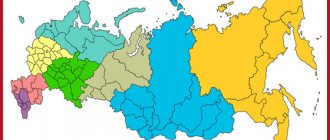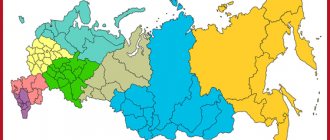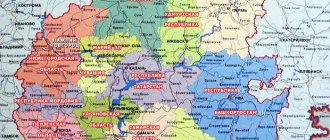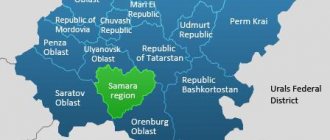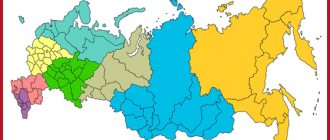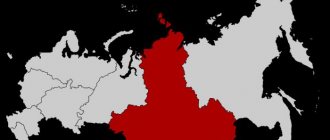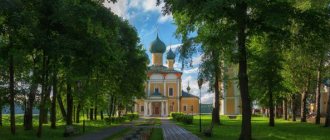The Bryansk region was formed by the Decree of the Presidium of the Supreme Soviet of the USSR on July 5, 1944. It included 26 western districts of the Oryol region. The territory of the region extends from west to east for 270 kilometers, and from north to south for 190 kilometers. The coordinates of its extreme northern and southern points are 54° 05′ and 52° 10′ north latitude, the extreme western and eastern points are 31° 10′ - 35° 20′ east longitude.
Of all the central regions of the Russian Federation, the Bryansk region extends most deeply to the west into the borders of two neighboring fraternal republics: Ukraine and Belarus.
General characteristics of the Central Federal District
The Central Federal District has a population of 39 million 216 thousand people. This is almost 27% of the entire population of the Russian Federation. Density: 60.3 people per square kilometer. The urban population accounts for 82%, cities - 310. In general, the district consists of small areas, however, they are all densely populated.
It has no access to the sea or the world's oceans. The total area is 650,205 square kilometers. It is noteworthy that the Central Federal District consists entirely of regions (except for Moscow). The district has borders with two countries: Belarus in the west and Ukraine in the southwest.
Climate and geography of the Central Federal District
The Central Federal District is located on the East European Plain, there are a number of hills (Central Russian, Valdai), but in general the territory of the district can be considered flat, there are no high mountains here. The highest point is 347 meters. Natural zones: mixed forest and deciduous forest mainly in the north, steppe and forest-steppe mainly in the south.
The climate throughout the Central Federal District is temperate continental, the average temperature depends on the latitude, ranging from -7 to -14 in January and from +16 to +22 degrees Celsius in July.
The largest rivers of the Central Federal District: Western Dviga, Dnieper, Don, Volga. There are practically no large lakes, but there are many reservoirs, which are the most significant water bodies (Rybinskoye, Kostroma, etc.).
Bryansk
A city in the Russian Federation, the administrative center of the Bryansk region, a city of regional significance, forms the municipal entity of the city of Bryansk with the status of an urban district.
It is located on the western edge of the Central Russian Upland, on both banks of the Desna River at the confluence of the Bolva and Snezheti.
The city is divided into 4 urban districts: Bezhitsky (includes the village of Raditsa-Krylovka), Volodarsky (includes the village of Bolshoye Polpino), Sovetsky, Fokinsky (includes the urban village of Belye Berega).
Bryansk is a large cultural, industrial center and logistics hub. The city is located in central Russia on the border with Ukraine and Belarus.
About a third of the region’s population lives in the city - about 420 thousand people (data for 2021). The total area of the city is 230 square kilometers.
History of the city of Bryansk
Bryansk, one of the oldest Russian cities, was founded in 985 as a Slavic fortified settlement on the high right bank of the Desna River. The original name of the city - "Debryansk" - is associated with the "wilds" surrounding the city - dense and impenetrable forests. Bryansk was first mentioned in the Ipatiev Chronicle in 1147: Prince Svyatoslav Olgovich of Novgorod took refuge in it. At this time, the city was part of the Chernigov principality.
Since 1252, the city acquired the status of the capital city of the appanage Bryansk principality, founded in 1246 by Prince Roman of Chernigov, who moved his capital here from Chernigov, devastated by Khan Batu. Under him, Bryansk became the political, economic and spiritual center of the region.
In 1356, the Principality of Bryansk was captured by the Grand Duchy of Lithuania, under whose rule Bryansk was for almost a century and a half. Only in 1500 did Russian troops capture the city. In 1503, after the end of the war between Ivan III and Lithuania, the northern part of the Bryansk Principality finally became part of the Moscow state.
Since that time, Bryansk has become an important fortress city on the southwestern borders of the state. At the same time, in the 16th century, on the site of the former Bryansk principality, the Bryansk district was formed, governed by governors.
During the Peter the Great era, a number of decrees were issued aimed at boosting industry and trade in the city. The annual fair held at the walls of the Svensky Monastery, one of the largest fairs in Russia, acquired a large role.
In 1708, Peter I visited Bryansk. By order of the tsar, a shipyard was founded in the city, where ships of the Bryansk flotilla were built.
In 1778, Bryansk became a county town in the Oryol province with its own coat of arms, noting its merits in the production of weapons and defense of the state.
In 1783, by decree of Catherine II, the construction of the Bryansk Arsenal began, and by the spring of 1785 the first cannons were cast here. Every fourth cannon that was in service with the Russian army in the Patriotic War of 1812 bore the mark of the Bryansk Arsenal. Rope spinning, tobacco, brick, sawmill and flour milling industries also developed in the city. Trade in timber, hemp, and hemp oil, sent to Moscow and the ports of Riga and St. Petersburg, was significant. By that time, the city had more than 13 thousand inhabitants.
With the construction of the Orel-Vitebsk railway in 1868, Bryansk was included in the transport network of Russia. In 1873, a rail rolling and iron-making mechanical plant was founded in the village of Bezhitsa, which soon became the largest enterprise for the production of steam locomotives and carriages.
After the Civil War, the city of Bryansk briefly became the center of a new territorial entity - the Bryansk province (1921-1929), after which it became part of the Western and then the Oryol region. During the Soviet period, the city grew into a major industrial center of the country. In 1931, the Bryansk State District Power Plant, built according to the GOELRO plan, came into operation.
The fighting during the Great Patriotic War and the occupation (October 1941 - September 1943) destroyed the city. The dedication of the residents who formed the people's militia, which bravely resisted the invaders, brought Bryansk the honorary title “City of Combat and Partisan Glory.” On September 17, 1943, Bryansk was liberated. Nowadays this day is celebrated as City Day.
In 1944, Bryansk became a regional center and in November 1945, by a special decree of the Soviet government, it was included in the list of fifteen oldest Russian cities subject to priority restoration. After the war, restoration began with the machine-building (locomotive) plant, which already produced the first steam locomotive in 1946.
In 1979, the city was awarded the Order of the October Revolution for success in economic and cultural construction, services in the revolutionary movement, courage and fortitude of workers during the Great Patriotic War, and active participation in the partisan movement. In 1985, for achievements in economic and cultural construction and in connection with the 1000th anniversary, Bryansk received the Order of the Red Banner of Labor.
On March 25, 2010, for the courage, resilience and mass heroism shown by the city’s defenders in the struggle for freedom and independence of the Fatherland, Bryansk was awarded the honorary title of the Russian Federation “City of Military Glory.”
Archeology
According to the Bryansk Museum of Local Lore, it currently contains more than 90 thousand items. This is one of the largest and most significant collections. It includes items discovered during archaeological research in the Bryansk region: tools, beads, bracelets, rings and other various finds.
Of particular value are the items discovered during the study of famous archaeological monuments of the Bryansk region: Khotylevo, Negotino, Eliseevichi, Timonovka, Yudinovo, Suponevo... The Bryansk region is rich in archaeological monuments, there are about 900 of them on its territory.
One of the oldest artifacts discovered in the Bryansk region is a flint spear tip. It is about 100 thousand years old. Despite such a considerable age, it is a real masterpiece in terms of care and beauty. The tip was found by an outstanding archaeologist and employee of our museum, Fyodor Mikhailovich Zavernyaev, at the Khotylevo-I site, 20 km from Bryansk.
At the neighboring parking lot Khotylevo-II F.M. Zavernyaev discovered two figurines of a woman made from mammoth ivory under a four-meter thick layer of earth. The age of these finds is about 18 thousand years. The figurines are one of the oldest works of art in the world. This is how the first “Paleolithic Venuses” appeared in the museum’s collection – this is the name these figurines received. These figurines are an archaeological rarity: about 100 of them have been found in the world.
Paleolithic collections from the funds of the Belarusian State Conservatory are comparable in volume, significance and value only to the collections of such major academic museums in Moscow and St. Petersburg as the State Historical Museum, the Museum of the Research Institute of Anthropology of Moscow State University, and the Kunstkamera.
Every year, domestic and foreign researchers work with the museum’s collections: archaeologists, philologists, museum employees, graduate students and undergraduates.
Coat of arms of the city of Bryansk
The Bryansk coat of arms is one of the oldest coats of arms of Russia; it was created in the first half of the 18th century. The opportunity to use an ancient coat of arms is a rare and high honor, which out of more than 20,000 municipalities currently existing in Russia can be enjoyed by less than 500.
For the first time, the coat of arms of Bryansk appeared on the banners of the Bryansk Landmilitary Regiment. Its first description appeared in 1730 in the collection of banners of the regiments of the Russian Empire - Znamenny Armorial. In 1781, Empress Catherine II, together with other coats of arms of the cities of the Oryol governorship, approved the coat of arms of the district city of Bryansk.
Description of the coat of arms
In the Russian State Archive of Ancient Acts in the “Coats of Arms of Cities and Counties of the Russian Empire” fund, the coats of arms of “regiments and battalions on banners and other regimental things”, submitted for approval by Catherine II on April 4, 1777, as city coats of arms, approved in 1775, have been preserved, including “Bryanskoy”, in color image. The upper field is red, on the lower field, which is a grass covering of green in different shades interspersed with brown, there is a golden mortar on a white carriage, on the sides of which there are pyramids of black cores with a white middle: on the right there are ten cores, on the left there are six cores of the same size.
The second description is contained in the Complete Collection of Laws of the Russian Empire in the “Book of Drawings and Drawings... of the Coats of Arms of Cities.” The chapter “Coats of Arms of the Oryol Viceroyalty” contains a lithograph of the coat of arms of the city of Bryansk with an image of a mortar standing on a carriage on a field and two pyramids of white cannonballs on its sides. The kernels on the left are larger, the kernels on the right are smaller. The image is black and white, there is a record of the approval of the coats of arms of the governorship on August 17, 1781. The symbol for the color of the top field is red. In the lower field, in addition to the image of the grass, several images of stones have been added.
The third brief description of the coat of arms of the city of Bryansk is contained in the “Description of the coats of arms of the cities of the Oryol governorship” with the appendix of the decree on the highest confirmation of coats of arms and sending copies to the governorship dated September 28, 1781. The following is reported about the coat of arms of Bryansk: “The city of Bryansk has an old coat of arms. In a red field there is a golden martyr with a pyramid of bombs placed on the sides.” This description of the coats of arms coincides with a similar description given in the Complete Collection of Laws in the text of the highest approved report of the Senate on the coats of arms of the cities of the Oryol governorship dated August 17, 1781.
Flag of the city of Bryansk
According to information sent by the Heraldic Council under the President of the Russian Federation, the flag of the city of Bryansk was drawn up with a deviation from the coat of arms principle adopted in our country: according to Russian traditions, city flags should be constructed by spreading the composition of the coat of arms over the entire panel. The flags of Moscow, St. Petersburg, and the vast majority of capital cities of the constituent entities of the Russian Federation are constructed in a similar way. In addition, flags built according to the German tradition (like the current flag of Bryansk - that is, with the coat of arms in a shield in the center of the panel), in addition to many other shortcomings, are non-functional and difficult to recognize from a distance. In this regard, the Chairman of the Heraldic Council, Georgy Vilinbakhov, pointed out the need to rework the flag of Bryansk and construct it according to the coat of arms principle.
Changes in the historical appearance of the coat of arms occurred in 2009, when city council deputies approved the official symbols of the regional center. According to their decision, the coat of arms of Bryansk began to be a French shield with a protruding point and lower rounded corners. The upper part of the shield is red, the lower part is green. The coat of arms contains golden mortars and cannonballs. Below them are depicted five elements, symbolizing young shoots of plants.
According to the Chairman of the Heraldic Council under the President of the Russian Federation, Georgy Vilinbakhov, on the coat of arms currently used, the golden shoots of plants in the lower part of the shield resemble arrows thrown on the battlefield, which, according to heraldic rules, indicates the weakness of the warriors and even their flight. It is also unacceptable to use the golden edging of the coat of arms, which symbolizes the deprivation of the merits of its owner. Also, to restore the original appearance, it is necessary to change the color of the cores from gold to black.
In addition, the Heraldic Council proposed supplementing the Bryansk coat of arms with elements reflecting the modern status of the city. In particular, the Heraldic Council developed a system of heraldic crowns for cities with different statuses. According to this, a five-tower crown can be added to the coat of arms of Bryansk, denoting the city district. A laurel wreath can be placed on the crown, indicating that Bryansk is the center of the subject of the Russian Federation. Also, due to the fact that in 2010 Bryansk became the City of Military Glory, crossed swords can be placed behind the crown as a symbol of this high rank.
Photo: Government of Bryansk region
Tourism in the Central Federal District
You can read more about tourism and the attractions of the Central Federal District in the descriptions of the regions. The district is very attractive for tourists; there are both natural and architectural attractions. Moscow alone attracts millions of tourists every year, but there is also the Golden Ring of Russia and hundreds of other interesting places.
From a tourism point of view, the Central Federal District stands out from almost all other districts due to its developed transport infrastructure. Almost any part of the district can be reached without problems, and there is no need to talk about popular and famous places.
Bridge across three states
The Bryansk region is known for its unique geographical and geopolitical position. It borders on two states at once - Ukraine and Belarus. This circumstance, coupled with the creative activities of the Bryansk leadership, is the most important tool for implementing the country’s foreign policy concept. The governor of the Bryansk region told a Rossiyskaya Gazeta correspondent about how it is being implemented in the Bryansk region.
We are partners
Nikolay Denin:
There are many threads connecting the Bryansk region with Ukraine and Belarus. The strongest of them is the thread of economic cooperation. But this cooperation cannot be defined only by the framework of business relationships. It is much deeper, which is facilitated by the centuries-old kinship of the three Slavic peoples. We have the same historical, geographical and ethnic roots.
In recent years, the Bryansk region has entered into a regime of sustainable dynamic development. In terms of such a key indicator as growth in industrial production, it is one of the leading Russian regions. This might not have happened if the region had not expanded and deepened trade and economic ties.
Russian newspaper:
Nikolai Vasilyevich, a number of projects and programs are being implemented in the Bryansk region, the goal of which is to improve people’s living standards. What is the role of international cooperation with foreign partners in this?
Denin:
The increasing role of cooperative ties with neighboring states. In this regard, our relations with the Gomel and Chernigov regions of the Republic of Belarus and Ukraine are indicative. They are characterized as the most stable and with real prospects.
Today, about five hundred enterprises with foreign investment operate in the Bryansk region. A significant part of them are represented by Belarusian investors. We are bound by 12 intergovernmental and regional cooperation agreements. Moreover, direct interaction, in my opinion, is the most effective.
RG:
What does the Bryansk region get from such cooperation?
Denin:
The results of cooperation are visibly expressed in numbers. Last year, the volume of foreign trade with the Republic of Belarus exceeded $200 million. 182 enterprises supplied the Belarusian market. There are 22 enterprises operating under the banner “Belarusian Goods” in the Bryansk region. Exports of wood products, spare parts for railway transport, bicycles, food products and raw materials for their production, petrochemical products and mechanical engineering are growing. Imports of Belarusian goods have also increased significantly - dairy and meat products, confectionery, paper and cardboard, machinery and equipment.
Klintsy enterprises actively cooperate with the Republic of Belarus - a piston ring plant, a truck crane plant, and a twine factory.
Novozybkovsky supplies high-frequency generators to Minsk. With the participation of Belarusian investors, a joint Russian-Belarusian enterprise for the production of soft toys began operating in Klintsy. Bryansk Ivot Steklo supplies basalt materials for gas stoves to Brest, Mogilev and Gomel.
There are many such examples. More than three and a half thousand tractors made in Belarus work in the fields of the Bryansk region.
RG:
One of the powerful incentives for the development of bilateral Russian-Belarusian cooperation is industrial cooperation in the form of creating joint ventures in various industries. How is this tool for strengthening integration ties used today in the Bryansk region?
Denin:
The consequence of our business relationship with the Gomel region was the implementation of an investment project related to the creation of a joint Russian-Belarusian enterprise CJSC JV Bryanskselmash. It specializes in the production of grain harvesting and forage harvesting equipment. One of the founders of the enterprise was the Belarusian Gomselmash. Constantly increasing production output, the company has made a real breakthrough. At the Russian Field exhibition, combines produced in Bryansk were awarded gold medals, and one of them even received the Grand Prix.
In September, a visiting meeting of the State Duma Committee on CIS Affairs and Relations with Compatriots was held in Bryansk, where they discussed the practice of cooperation between the Bryansk region and the border regions of Belarus and Ukraine. And before the meeting, our guests - State Duma deputies, representatives of Russian ministries and departments, authorities of several Russian regions, as well as our neighbors - Sumy, Chernigov and Gomel residents - visited Bryanskselmash.
RG:
Today, due to the foreign policy course of the Ukrainian president, many are talking about a cooling in relations between Russia and Ukraine. If this is so, then how does the Bryansk region, which is connected with Ukraine by many ties, survive this period?
Denin:
No, not at all. The indicators of foreign trade turnover of the Bryansk region and Ukraine are even more significant. Last year it exceeded $630 million. Mutually beneficial agreements connect the Bryansk region with the Zhitomir, Chernigov, and Sumy regions. The fruits of this cooperation are clearly visible at numerous joint exhibitions and product presentations in which foreign enterprises participate.
Recently, together with our Sumy colleagues, we solved a long-standing border problem. I'm talking about the section of the state border in the area of the Russian station Zernovo and the Ukrainian town of Seredina-Buda. The absence of a vehicle checkpoint in this area created a lot of inconvenience for residents of border areas. But they lived here together for a long time, and the border separated close people - elderly parents and adult children, aunts and nephews, friends and godmothers. In order not to waste time on a long detour, many of them decided to, so to speak, illegally cross the border.
There is an agreement between our countries that provides for the procedure for border crossing by residents of border areas. But in reality, its conditions were not met due to the lack of arrangement of crossing points. Now this issue has been resolved, and even a local bus will run across the border.
Special position and special tasks
RG:
This summer marks five years since the creation of the Bryansk, Gomel and Chernigov regions of the Dnepr Euroregion. It was planned that it would contribute to the development of cross-border contacts and the implementation of joint projects in various industries. Is it possible to talk about fulfilling these tasks?
Denin:
Euroregion "Dnepr" received observer status in the Association of European Border Regions (AEBR), and now the issue of granting the community the status of a full member is being considered. Within the community, specific tripartite projects in the fields of economics, environmental protection, education and the socio-cultural sphere are being successfully implemented.
It should be noted that there is active interaction within the Euroregion of chambers of commerce and industry. Exhibitions, fairs and investment forums contribute to the growth of mutual investments, expansion of the range of supplied goods, and the creation of joint ventures. At the end of summer, we held the traditional Svensk Fair in Bryansk, and the products of the community enterprise, as always, were in demand. In general, exhibitions and fairs are an amazing thing. In a few days it is possible to achieve such progress that only recently one could only dream of.
RG:
How would you comment on the results of cooperation between the regions of the Euroregion in the field of environmental management?
Denin:
As they say, only rains fall on our fields and only rivers flow through our lands. So we are simply doomed to preserve all this together. Moreover, we already have extensive joint experience in overcoming the Chernobyl disaster. To prevent and eliminate the consequences of emergency situations of a man-made or natural nature in border areas, the Department of the Ministry of Emergency Situations of Russia in the Bryansk Region and the Gomel Regional Department of the Ministry of Emergency Situations of the Republic of Belarus have agreed on a set of measures for interaction. This year, the Chernihiv region is joining this work.
The three regions agreed to actively cooperate in the prevention of transboundary pollution of water bodies and the protection of flora and fauna. In particular, the analytical laboratory of the Gomel Regional Committee for Natural Resources and Environmental Protection, together with the Bryansk branch of the Center for Laboratory Analysis and Technical Measurements, is conducting a joint study of the Iput River.
RG:
How is international cooperation developing in the field of humanitarian ties?
Denin:
Interaction and mutual understanding are very important here. It is. Bryansk State University named after I. Petrovsky actively cooperates with Belarusian partners.
Students, young scientists, and teachers at universities in neighboring countries have long become close to each other. And not only universities. There is a pedagogical college in the city of Surazh, Bryansk region. Every fourth student of this educational institution is a citizen of Belarus. It is no coincidence that the international conference “Formation of a single educational space” was held here, at which an agreement was reached on cooperation in the field of education between the Bryansk and Mogilev regions. It provides, in particular, for joint training of primary school teachers.
The international festivals “Slavic Theater Meetings”, which are held in Chernigov, Gomel and Bryansk, have long become traditional and beloved.
Representatives of Russian, Belarusian and Ukrainian media have long-standing business contacts. Joint newspaper releases, creative trips, press tours - these and other forms of cooperation enrich each of the parties. Even the “Bryansk Men”, this is our KVN team, take part in competitions of the same clubs for the prize of the Chernigov mayor. So this is real public diplomacy!
Optimism of public diplomacy
RG:
This is an interesting topic. Public diplomacy, as a way of bringing ordinary people closer together, acts together with the state in dialogue with other countries and cultures. How effective are projects in this area?
Denin:
I am convinced that it is public diplomacy that is the engine in expanding contacts and bringing peoples closer together, in forming a belt of good neighborliness along the perimeter of Russian borders and in preventing potential conflicts. I also believe that the involvement of young citizens of neighboring Slavic peoples in this activity is a good basis for future integration processes.
RG:
You are talking about the “Slavic Unity” festival...
Denin:
And about this too. “Slavic Unity” is a unique festival. The fact is that the Bryansk region is not just a border region. There is a point on her map where three borders meet at once. People call this place the junction. Once upon a time there was just a swamp. Now, from each country, three wide roads lead here, and in the center rises a mound with a monument to Friendship, which also received the popular name - “Three Sisters”. Three white ringed pylons majestically rush into the sky as a symbol of the blood unity of the Slavs.
One day a year, an ordinary miracle occurs here. About one hundred thousand people from Belarus, Russia and Ukraine come together for a common holiday. On this day, border rules cease to apply, no one asks for passports, and the currencies of three states are in use. This summer the festival was held for the 40th time.
One Ukrainian journalist who visited the festival wrote well in a Kharkov newspaper: “We don’t need to be forced to be friends. We are neighbors, and we have a common house - at least within this separate joint. And in any decent home they remember both the common roots and the difficult times when troubles were overcome by the whole world, regardless of nationality.”
At the above-mentioned meeting of the State Duma Committee on CIS Affairs, its members expressed their intention to contact the Ministry of Culture with a proposal to give the International Festival “Slavic Unity” the status of a national festival with appropriate funding from the federal budget. State Duma deputies will also petition for the inclusion of the project to create the Slavic Ring tourist route in the corresponding federal program. They expressed confidence that another of our initiatives will receive support from the executive authorities of Russia - the creation of a Russian-Belarusian university on the basis of Bryansk State University and a Russian-Belarusian college on the basis of Surazh College, every fourth student of which is a citizen of Belarus.
RG:
How did the residents of the Bryansk region perceive the tragic events in South Ossetia?
Denin:
Like all normal people - with pain and sympathy. Moreover, this sympathy had a specific material component. The collection of humanitarian aid in the region began almost immediately after the events began. It was attended by public organizations, enterprises, and ordinary residents of the region.
The Bryants delivered their cargo, which contained food, clothing, building materials, and medicines, directly to Tskhinvali. Moreover, it turned out to be very timely: the only bakery in the city ran out of flour at that moment. In the near future, another humanitarian caravan will be sent to Tskhinvali. At the same time, many Bryansk residents, including employees of the regional administration, wrote applications to transfer their one-day earnings to the fund for the victims.
What's next?
RG:
Were the factors of international cooperation taken into account when developing the Strategy for the socio-economic development of the Bryansk region for the period until 2025?
Denin:
The geographical location of the region and the associated market prospects will always be at the forefront. The Bryansk region is ready to cooperate with Ukraine, Belarus and other foreign countries in the implementation of joint projects. Joint work in various sectors of the economy, education, culture and simply public diplomacy - all this allows the Bryansk region to become a real bridge connecting Belarus, Russia and Ukraine.
Map of the Bryansk region with cities and villages
More detailed information about the location of settlements can be found on Yandex maps of the Bryansk region. Here you can determine the location of large regional centers, such as:
- Bryansk;
- Novozybkov;
- Trubchevsk;
- Mutilation;
- Dyatkovo;
- Klintsy.
They are connected by the largest highways, which are indicated in detail on the road map of the Bryansk region. For tourists who travel through the central part and southwest of Russia, such a map is an indispensable assistant.
The Bryansk region is crossed by 5 federal highways. Highways pass through 60 cities and towns and more than 200 railway sidings. The road routes of the Bryansk region on the map total more than 18,000 thousand km, connect regions of the region, and provide access to the borders with neighboring states.
The railway connection is also not only a connection between the region and other constituent entities of Russia, but also an outlet abroad. The railway map of the Bryansk region roads is presented in detail and gives a clear idea of the number of stations and directions. Railways stretch over a distance of more than 1,100 km, and suburban traffic is developing.
Bryansk region is an ancient and young region
Located almost in the center of the Russian Plain, the Bryansk region has long been distinguished by its advantageous position and played an important role in the protection of Russian lands and the Russian state.
The region's position on the watershed of two large river systems - the Dnieper and Volga - had a great influence on its settlement and economic development. The Dnieper, where the Desna carries its waters, has long been the main artery of the western part of the Russian Plain, connecting the Bryansk region with the Volga, Don, Western Dvina, and through them with the Caspian, Azov, Black and Baltic seas. The waterway “from the Varangians to the Greeks” drew the region into a wide range of trade relations.
Administratively, the Bryansk region is relatively young. It was formed on July 5, 1944 from the western regions of the Oryol region.
The Bryansk region lies in the western part of the Russian Plain, occupying the middle part of the Desna basin and the forested watershed between it and the Oka.
Located at the junction of three states and two natural zones, the region has a rich and diverse nature. Here you can find all types of forests: coniferous, mixed, broad-leaved, as well as forest-steppe and cultivated steppe.
The region borders with two states and four regions of the Russian Federation: in the west - with Belarus (Gomel and Mogilev regions, in the north - with Kaluga and Smolensk regions, in the east and southeast - with Oryol and Kursk regions, and in the south - with Ukraine ( Chernihiv and Sumy regions).
The nature of the region is rich and varied, its mineral reserves are great.
The famous Bryansk Forest is called the lungs of Central Russia.
If you look at the geographical map of the European part of Russia, the highest point of the Central Russian Plain - its crown - is located precisely in the Bryansk region.
The main river of the region, the Desna, already a thousand years ago was, firstly, the main waterway to the Kyiv Shrines, and secondly, a channel for the spread of book culture and enlightenment from the Middle East, Byzantium, Greece to the spiritual centers of northeastern Rus'.
The territory of the Bryansk region has been inhabited by Slavic tribes since ancient times. In the 9th-11th centuries, northerners lived along the Desna, and on the forested watershed of the Desna and Oka - the Vyatichi and Radimichi. The history of the region is full of countless examples of how its inhabitants have always been among the faithful defenders of the Fatherland. The selfless struggle of the Trubians with the Polovtsians in 1185 was sung in the “Tale of Igor’s Campaign” and was reflected in the granite monuments that decorate the cities of the region.
The inhabitants of the region showed boundless love for their homeland in 1240, courageously resisting the Mongol-Tatar conquerors.
The centuries-old history of our region is a reflection of the historical, cultural, and spiritual experience of Russia. A special page in the history of Russia is the Battle of Kulikovo. “The squads of individual principalities of north-eastern Rus' went to the Kulikovo field, and the united Russian people returned.” Our fellow countryman, Bryansk boyar, and later monk, Peresvet wrote a glorious page in the history of the formation of the Russian state. Residents of the Bryansk region actively participated in the defeat of the German “dog knights” at Grunwald in 1410, the Polish-Lithuanian lords at the beginning of the 17th century, and defeated the troops of Charles XII and Napoleon.
The centuries-old history of our region is a reflection of the historical, cultural, and spiritual experience of Russia.
One of the brightest and most amazing pages in the history of World War II is the partisan movement in the Bryansk region. There is not a person in our country who does not know the song “The Bryansk Forest Made a Severe Noise.” This song is the anthem of the Bryansk region.
On a vast territory behind enemy lines, the partisans liberated and held over 500 villages and hamlets with a population of about 200 thousand people.
There is a place in the Bryansk region about which they say: “When the rooster crows there, they hear it in Belarus, and in Ukraine, and in Russia. This place is at the junction of three Slavic states. A Friendship Monument was erected here, and annual youth festivals are held here. The Bryansk region has absorbed the language, folk wisdom, traditions, and customs of three Slavic peoples.
The cultural traditions of the region are deep and rich. Bryansk region is the birthplace of Fyodor Ivanovich Tyutchev, singer Anastasia Vyaltseva... Alexey Konstantinovich Tolstoy, composer Sergei Taneyev, artist Vrubel lived and worked here in different years... The creativity of folk artists and performers is unique. The products of Dyatkovo crystal makers are known throughout the entire country outside its borders.


